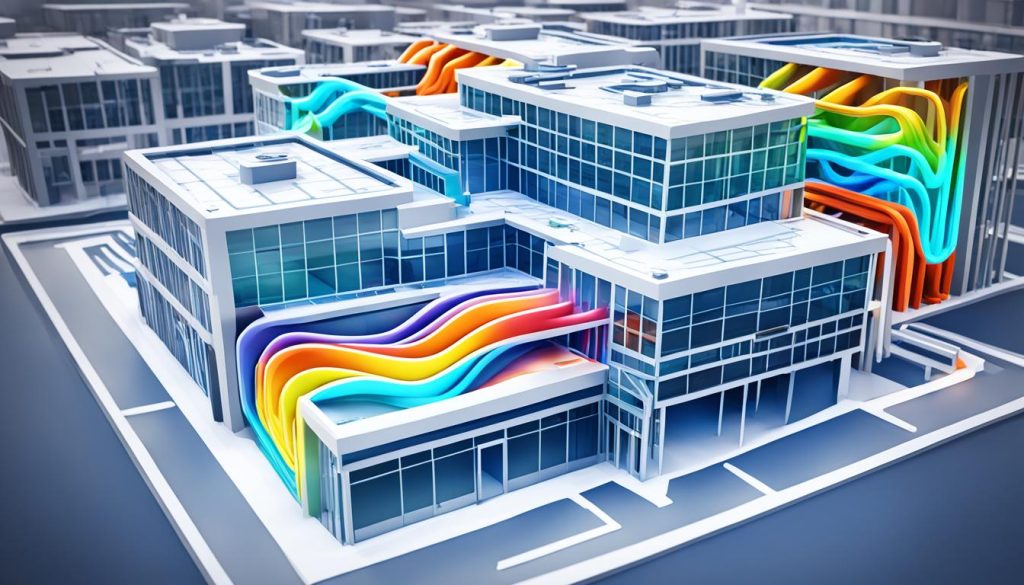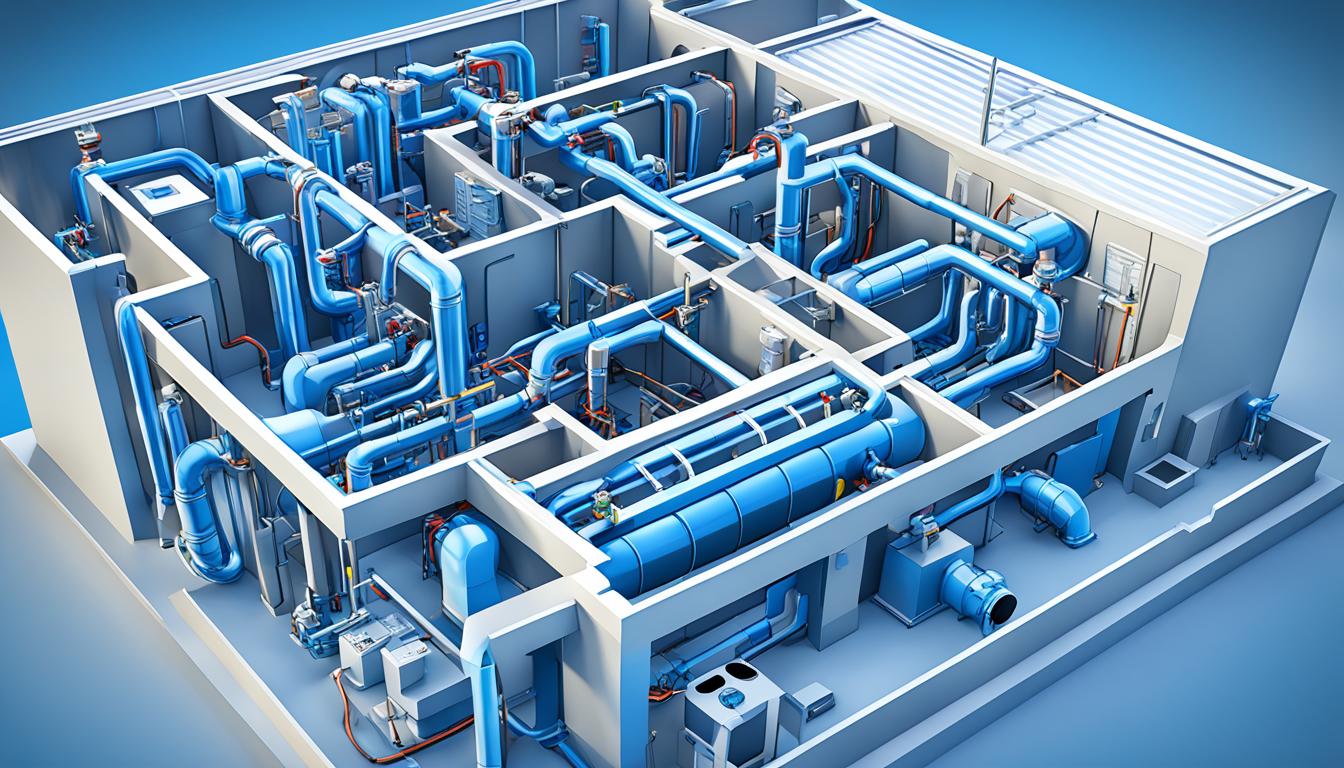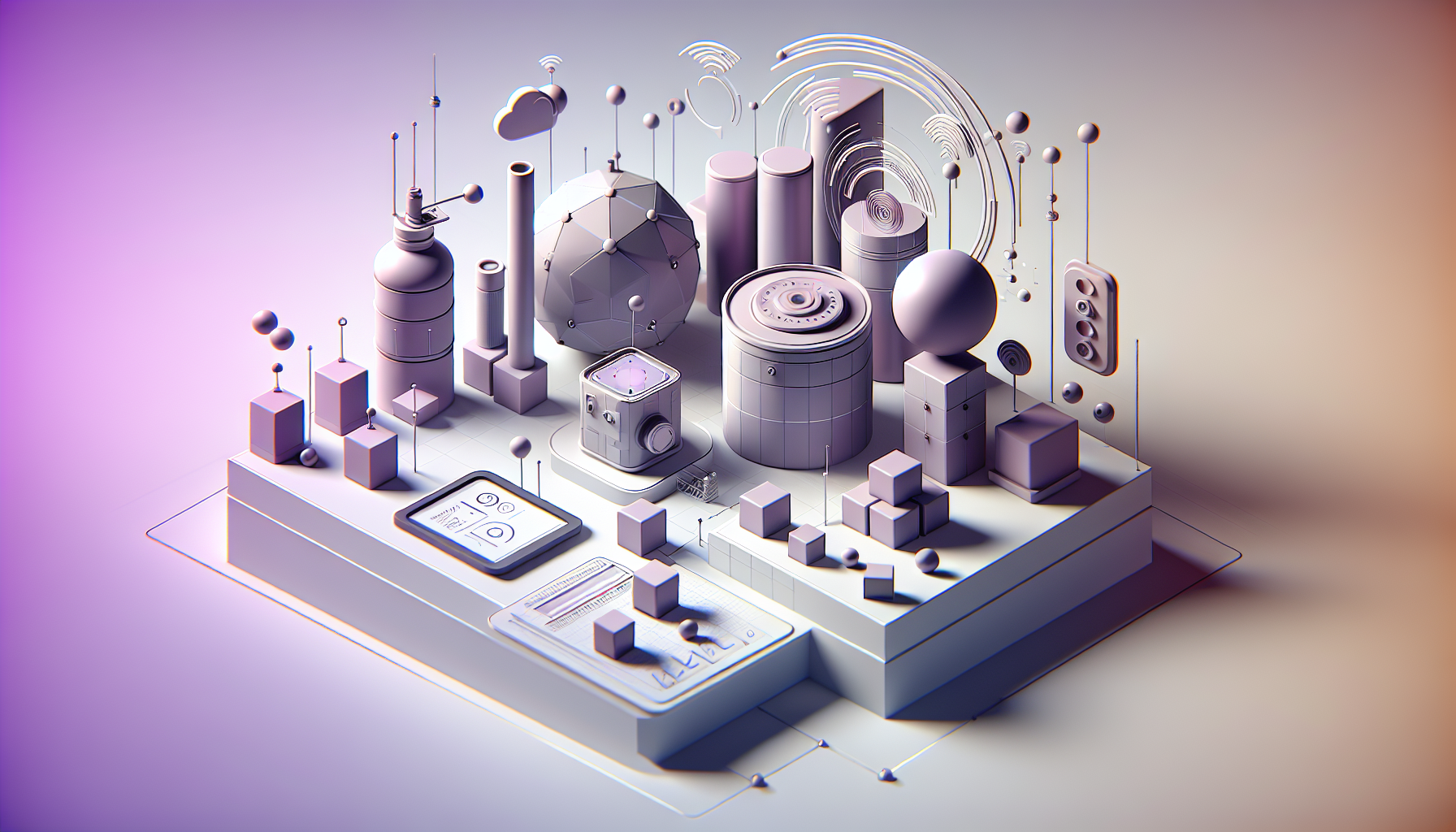3D modeling in HVAC load calculation software can make your designs better. It lets you see complex systems clearly, improve accuracy, and boost building performance.
3D modeling has changed HVAC design for the better. It helps you meet the complex needs of today’s buildings. With detailed views of shading, daylight controls, and room layouts, you can make systems more efficient and perform better.
Adding 3D modeling to your HVAC load calculation software makes designing easier. It helps spot mistakes and checks your designs more precisely. This means more accurate load calculations and better HVAC systems for your projects.
Introduction to 3D Modeling in HVAC Design
HVAC design has changed a lot from manual drafting to using 3D modeling. This change has changed how engineers work on heating, ventilation, and air conditioning systems in buildings.
Evolution of HVAC Design Techniques
Before, HVAC designers used hand-drawn blueprints and basic CAD software. Now, advanced 3D modeling tools have changed the industry. These tools help with precise product visualization and make design easier.
Importance of 3D Modeling in Modern HVAC Systems
3D modeling is key for dealing with complex building designs and energy efficiency needs. It lets designers make virtual mockups, see airflow patterns, and improve system performance before installing anything.
Benefits of Using 3D Modeling Software
HVAC designers get a lot from 3D modeling software. It offers:
- Enhanced visualization of system components
- Accurate load calculations
- Seamless integration with Building Information Modeling (BIM)
- Improved collaboration among project stakeholders
- Reduced errors and rework during installation
Using these benefits, HVAC professionals can make designs that are efficient, cost-effective, and sustainable. They can quickly try out different designs to optimize system performance. They consider things like building orientation and material thermal properties.
Understanding HVAC Load Calculation Software
HVAC load calculation software is key for designing efficient heating and cooling systems. It helps figure out the exact heating and cooling needs for any building. This ensures comfort and saves energy.
When using this software, you enter details that affect a building’s heat and cool performance. These include:
- Building shape and direction
- Materials and insulation used
- Types and sizes of windows
- How people use the building
- Weather in the area
The software uses this info to work out the exact heating and cooling needs. Getting this right is crucial. It helps pick the right HVAC size to prevent waste and discomfort.
Energy analysis is a big part of the software too. It looks at different system designs and how they use energy. This helps you make smart choices to save energy.
Thermal comfort is what HVAC design aims for. The software simulates indoor conditions to make sure your design keeps people comfortable. It looks at air temperature, humidity, and air flow to create the perfect indoor space.
Building code compliance is easier with this software. It makes sure your designs follow local and national standards. This saves time and money on revisions later.
With 3D modeling, these tools give even more precise results. They show heat gain and loss in detail, leading to better HVAC designs.
Key Features of 3D HVAC Design Software
3D HVAC design software has changed how we plan and put together heating, ventilation, and air conditioning systems. These tools have many features that make designing better, more accurate, and help everyone involved understand the project.
Parametric Modeling Capabilities
Parametric modeling lets you make smart 3D models with parts that work together. This means you can quickly try out different HVAC designs and see how they work. You can change things and watch how the whole system changes too.
This helps you find the best design for your HVAC system fast.
Spatial Coordination and Clash Detection
3D HVAC software is great at working with other building systems. It helps you see and fix any problems with HVAC parts and other building elements. This way, you can avoid mistakes and save money by not having to change things on the site.
Realistic Rendering and Visualization Tools
Today’s 3D HVAC software has amazing tools for making designs look real. These tools let you show your HVAC designs to clients in a way they can understand. With detailed 3D models, complex systems become easier to grasp, making it better for everyone to talk about the project.
| Feature | Benefit |
|---|---|
| Parametric Modeling | Enables quick design changes and system optimization |
| Spatial Coordination | Reduces conflicts and improves building system integration |
| Realistic Renderings | Improves client communication and project visualization |
Using these key features, you can make HVAC designs that are efficient, precise, and look great. The mix of quick prototyping, working together, and realistic images lets you give top-notch HVAC solutions. These solutions meet both the technical needs and what the client wants.
Integrating 3D Modeling with Building Information Modeling (BIM)
Combining 3D modeling with Building Information Modeling (BIM) changes HVAC design for the better. This mix boosts project coordination and makes working together easier. It creates a single platform for sharing data across different areas.

BIM integration helps build models without clashes. This leads to fewer mistakes and smoother projects. Teams can share info in real-time, improving communication and project efficiency.
Benefits of BIM Integration in HVAC Design
- Enhanced project coordination
- Seamless data exchange between teams
- Reduced errors and conflicts
- Improved decision-making process
- Faster project completion
With BIM integration, you can see the whole HVAC system in the building. This view helps spot problems early in design. It makes it easy to find clashes with other building parts, saving time and money during construction.
Working together becomes easier with a single, shared model. Architects, engineers, and contractors can see the latest info. This coordination leads to better designs and smoother projects.
Utilize 3D Modeling for Better Designs
3D modeling changes HVAC design by making it easier to see, improve load calculations, and speed up the design process. This new method leads to designs that are more efficient and save money. It also supports building in a way that is good for the planet.
Enhanced Visualization and Communication
3D modeling makes HVAC designs come alive, letting you see the whole system. This helps spot problems early, avoiding expensive mistakes. It also makes talking with clients and your team easier, making sure everyone gets the design.
Improved Accuracy in Load Calculations
Using 3D modeling with HVAC load calculation software makes your designs more precise. The software looks at complex shapes, room positions, and how they connect. This means your load calculations are more accurate. This leads to systems that use less energy and work better.
Streamlined Design Process and Iterations
3D modeling makes designing faster by allowing quick changes and tests. You can try out different ideas and adjust them easily to find the best approach. This saves time and leads to designs that are more creative and good for the environment.
| Benefit | Impact on Design | Result |
|---|---|---|
| Enhanced Visualization | Early issue identification | Reduced errors and costs |
| Improved Load Calculations | Greater system precision | Optimized energy efficiency |
| Streamlined Process | Faster iterations | Innovative, sustainable designs |
Using 3D modeling in your HVAC designs lets you make systems that are more efficient, precise, and good for the planet. These systems meet today’s building needs and what clients want.
Optimizing HVAC System Performance through 3D Modeling
3D modeling changes the game for HVAC systems, making them more efficient and sustainable. It uses advanced software to design systems that save energy and make people more comfortable. This leads to better designs that use less energy and make people happier.
Energy Efficiency Analysis
With energy modeling, you can test different HVAC setups to find the best one. You can play with building designs, materials, and system setups to see how they affect energy use. This helps you spot ways to save energy and make better choices.

Thermal Comfort Simulations
Simulation tools let you check how comfortable a building will be. You look at temperature, humidity, and air flow to make sure it’s just right for everyone. These tools find trouble spots early, so you can fix them before building starts.
Airflow and Ventilation Optimization
3D modeling lets you see and improve how air moves in a building. You can check ducts, diffusers, and air units to make sure air flows well. This makes the air clean and fresh, and helps the system work better.
| Optimization Aspect | Benefits | Tools Used |
|---|---|---|
| Energy Efficiency | Reduced energy consumption, lower operating costs | Energy modeling software, building simulation tools |
| Thermal Comfort | Improved occupant satisfaction, increased productivity | Comfort analysis software, CFD simulations |
| Airflow Optimization | Enhanced indoor air quality, balanced temperature distribution | Computational fluid dynamics (CFD) software |
Using these methods, you can make HVAC systems work better than expected. 3D modeling gives you the data you need to make smart choices. This leads to buildings that are efficient, comfortable, and good for the planet.
Overcoming Challenges in 3D HVAC Modeling
Starting with 3D HVAC modeling brings its own set of challenges. The steep learning curve of the software needs time and effort. Managing data becomes key as projects get bigger and more complex. You might also face issues when working with teams using different software.
To overcome these challenges, here are some strategies to consider:
- Invest in comprehensive training programs for your team
- Implement robust data management systems to organize and store project files
- Choose software that supports industry-standard file formats for better interoperability
Overcoming these hurdles is crucial to fully benefit from 3D HVAC modeling. By improving your team’s software skills, setting up good data management, and solving interoperability problems, you’ll make better HVAC designs.
| Challenge | Solution |
|---|---|
| Software learning curve | Regular training sessions, online tutorials, peer mentoring |
| Data management | Cloud-based storage, version control systems, regular backups |
| Interoperability issues | Use of open file formats, middleware solutions, API integrations |
By tackling these challenges, you’ll make your 3D HVAC modeling process smoother and more efficient. Keep at it, and you’ll see the benefits of mastering this design method.
Best Practices for Implementing 3D Modeling in HVAC Design
When you start using 3D modeling in HVAC design, planning is key. Focus on areas that make your design process better and your results more accurate.
Training and Skill Development
Getting better at 3D modeling in HVAC design means learning more. Look for training that covers the software, design rules, and what’s standard in the industry. Regular workshops and seminars help keep your team in the loop with new techniques and tech.
Establishing Workflow Protocols
Make sure your 3D modeling projects have clear steps. Know who does what and how everyone will talk to each other. Have checks to keep the quality high during design. This way, you avoid mistakes and work more efficiently.
Ensuring Data Integrity and Model Accuracy
For trustworthy HVAC designs, checking your data is a must. Make sure to double-check all the data and model results. Use tools that spot mistakes automatically and check your 3D models often.
- Conduct peer reviews of models
- Compare results with manual calculations
- Use standardized templates for consistency
By sticking to these best practices, your 3D HVAC models will be more accurate and reliable. This means better designs, fewer mistakes, and happier clients.
Future Trends in 3D HVAC Modeling and Load Calculation
The future of 3D HVAC modeling and load calculation is exciting. We’ll see big changes that will change how HVAC systems are made, improved, and kept up.
Artificial intelligence will be a big deal in HVAC modeling. Machine learning will look at lots of data to guess how systems will work, use energy, and need maintenance. This means HVAC designs will get smarter and use less energy, adapting to the environment.
Virtual reality will change how HVAC pros work with their designs. You’ll be able to walk through virtual HVAC systems, making it easier to spot problems and plan layouts before building starts.
Augmented reality will connect digital models with real-world HVAC parts. AR glasses will show digital info on real parts, making maintenance and fixing things easier.
| Technology | Application in HVAC | Expected Impact |
|---|---|---|
| Artificial Intelligence | Predictive analysis, system optimization | Improved energy efficiency, reduced downtime |
| Machine Learning | Load calculation, performance forecasting | More accurate designs, adaptive systems |
| Virtual Reality | Design visualization, collaborative planning | Enhanced decision-making, fewer errors |
| Augmented Reality | Maintenance support, installation guidance | Faster repairs, improved technician efficiency |
As these technologies get better, we’ll see more accurate load calculations and better system designs. They’ll work well with smart buildings. The future of HVAC modeling looks bright, promising more comfort, sustainability, and efficiency.
Conclusion
3D modeling has changed HVAC design, making it more precise and efficient. This technology lets you create sustainable designs for today’s complex buildings. It helps you make better decisions and use energy more wisely.
Using 3D modeling in HVAC projects makes it simpler to improve system performance and cut energy use. It supports the trend towards sustainable design in construction. With 3D modeling software, you can adjust your designs for the best efficiency.
Future tech will keep changing the HVAC industry. 3D modeling will be key in making systems work better and use less energy. By keeping up with new tech, you can design HVAC solutions that are good for buildings and meet changing needs.





0 Comments